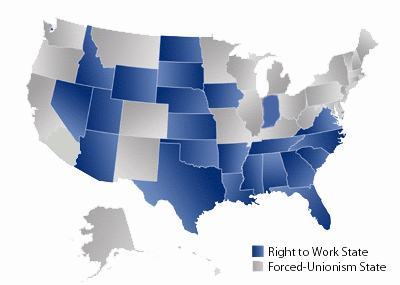Prosperity Reigns in Right to Work, Low Tax States
According to the March 29th Richard Rahn (Newsmax) article, Right to Work and Lower Taxes appear to deliver a one-two punch in states fights against unemployment and personal income decline. In fact, Right To Work states lead in economic prosperity and personal income growth.
State Economic Climate
Economic Performance Ranking
2010
Business Tax Climate Ranking
2011
Small Business Survival Ranking 2011
Population Growth 2000-2010
Right to Work
Florida
5
5
6
17.6%
Yes
Virginia
8
12
14
13.0%
Yes
Tennessee
10
27
11
11.5%
Yes
Texas
19
13
3
20.6%
Yes
California
46
49
48
10.0%
No
New Jersey
48
48
50
4.5%
No
New York
50
50
49
2.1%
No
Sources: American Legislative Exchange Council, Tax Foundation, Small Business and Entrepreneurship Council, U.S. Census Bureau, National Right to Work Legal Defense Foundation.
From Rahn's article:
“Fiscal crisis hits the states” has become this year’s most boring and repetitive headline. But what is largely overlooked is that some states are doing relatively well — such as my home state of Virginia — and are, in fact, balancing their budgets without draconian budget cuts or tax increases.
Given the ongoing fight between public-employee unions and some state governors, it is interesting to observe that the “right to work” states (that is, those states where workers are not forced to join a union against their will in order to obtain a specific job) also had much better performances than in those states where workers are not protected from involuntary unionism.




